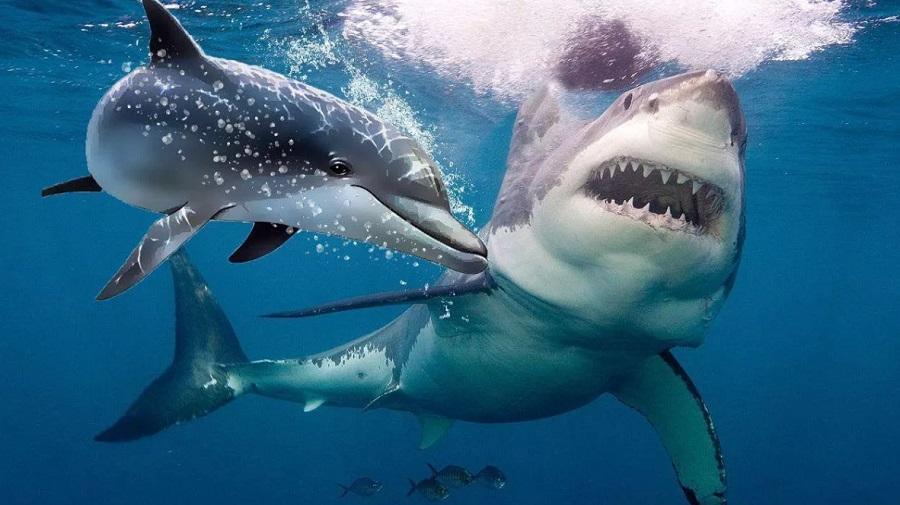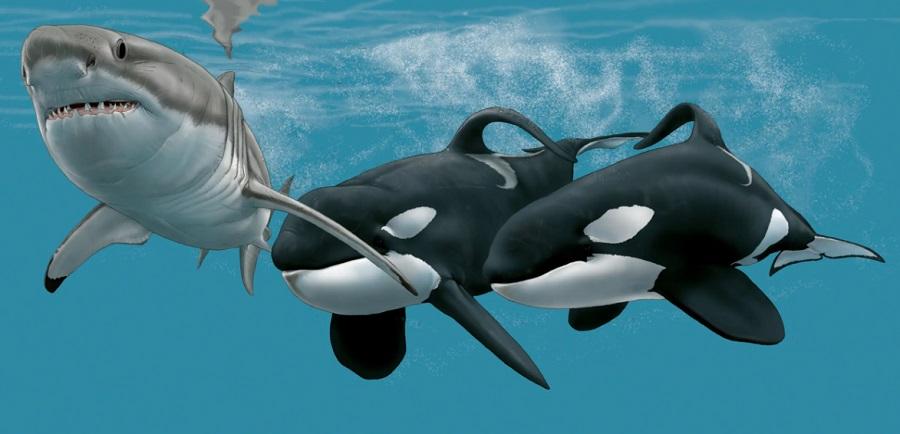
Intelligence wins
Dolphins, famous for their friendliness, belong to the class of mammals, while sharks, with a reputation for cruelty and unpredictability, belong to the fish. An interesting fact is that sharks prefer to stay away from dolphins. Each meeting of these marine inhabitants often turns into a tense confrontation.
This makes us think about the reasons for their mutual hostility and the ability of a mammal to resist such a dangerous predator. How is it that sharks, known for their ferocity, avoid collisions with dolphins and what makes them shy away from such encounters, where it turns out that a powerful predator is at a disadvantage to a mammal?
Sharks, the fear and awe of the depths of the sea, are striking in their size – adult white sharks reach up to 5 meters in length and weigh from 650 kg to 3 tons. They have three-row sharp teeth capable of piercing any prey, and special scales that protect them from parasites and bites from other predators.
These fish are skilled killers: they have an excellent sense of smell, keen eyesight, and sensitive hearing, are able to detect movement at a distance of 90 meters and reach speeds of up to 20 km/h. However, their intelligence is quite limited, with a brain weight of only 50 grams.
On the contrary, dolphins, despite being inferior to sharks in size and strength, are distinguished by their high intelligence. Their brains are more than 30 times heavier than those of sharks and are comparable in complexity to those of primates and humans. This provides dolphins with a tactical advantage, allowing them to be more maneuverable and fast, reaching speeds of up to 30 km/h.
Dolphins use their muzzle, reinforced with thick bones, as a battering ram weapon. Their intelligence allows them to effectively use this method of attack, even against more powerful sharks, capable of delivering fatal blows.
The advantage of collective action

Indeed, sharks sometimes hunt dolphins, usually choosing single individuals as prey. Using the element of surprise, the predator attacks the dolphin from a blind spot – from above or below, grabbing it across the body and trying to drown it.
However, dolphins usually live in groups. When they detect a threat from a shark, they can collectively attack it. If the shark does not manage to leave in time, it can become a victim of a group dolphin attack.
Research shows that dolphins can sometimes initiate attacks on sharks, especially during periods when female dolphins are going into labor. Then a flock of dolphins surrounds a vulnerable female and attacks any predator in the area.
In light of this potential threat, sharks tend to try to avoid schools of dolphins. Interestingly, even a small group of 2-3 dolphins can be enough to make a shark retreat.
The killer whale, a member of the dolphin family, not only protects itself from sharks, but also actively hunts them. These two marine creatures are comparable in size and strength, but the killer whale has an advantage due to its intelligence.
Using its powerful fins, the killer whale is able to flip the shark onto its back, after which it attacks it, aiming at the liver. Scientists believe that it is this part of the shark’s body that attracts killer whales, since the shark’s liver weighs up to 450 kg, of which about 400 kg are low-density fats, being a high-energy source of nutrition.
After the killer whale eats the shark’s liver, it usually leaves, leaving the rest of the carcass untouched. This behavior highlights the killer whale’s strategic approach to hunting and resource use.
Sharks often get an undeservedly bad reputation because of their portrayal in literature and cinema. Sharks often confuse swimmers with seals. Humans are not the preferred food for sharks, as they contain too many bones and too little fat.
Unlike sharks, dolphins can sometimes attack humans deliberately, either for fun or because of sexual arousal, which is part of their behavioral repertoire.


